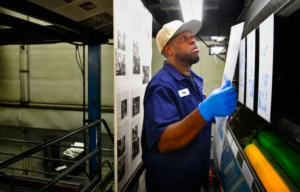Was James Brown murdered? How one phone call led a CNN reporter to search for the truth
You’re a reporter and one day you get a phone call. The woman on the other end works in the circus. She tells you a crazy story: James Brown, the Godfather of Soul who died in 2006, was murdered — and she can prove it. What would you do?
If you’re Thomas Lake of CNN, your first thought is what most of us would think: “Who are you and how did you get my number?”
Lake had plenty to do that day two years ago. He was excited to start a new project about police-involved shootings. He was looking forward to writing about politics after that.
“But there was just something about Jacque (Hollander),” Lake said. “She seemed sincere and she seemed to have something important to say. So as wild and unusual and surprising as it was, I had to stop and think about it.”
He talked to his editor, Jan Winburn. Both came to the same conclusion. “We can’t know until we go see,” he said.
So Lake got on a plane. The result was an incredible three-part story about the bizarre world of Brown that might include multiple murders and a rape. The story has gone viral and has many calling for an autopsy or criminal investigation.

The body of James Brown is on display to the public at the Apollo Theater in New York, Thursday, Dec. 28, 2006. (AP Photo/Seth Wenig)
But how do you even begin to tell such a story? Lake said he traveled through nine states and interviewed nearly 140 people. He reviewed tens of thousands of pages of police and court records, more than 1,300 pages of text messages and dug through three storage units of records dating back 30 years. And there were moments when Lake wondered if he was chasing a mirage.
“That’s always the question,” Lake said. “If no one else has done this already, that must mean there is no merit to it, right?”
Hollander, the circus singer central to this story, had tried to get others, including police, to listen to her. Lake was the first one to take her seriously and put all the complicated pieces together.
Lake did what he always does on long features.
“I just take a blank white sheet of paper and I get a pen and I just start scribbling ideas,” Lake said. “Sometimes it will just be a list in the right-hand margin. But at some point, I’ll start to block out what the sections will look like.’’
Lake thought he had seven parts. He ended up with three, although he admits the final product was only “just a fraction’’ of his reporting. There could be plenty more to tell if there is an investigation.
All because Lake answered a phone call and listened.
Remembering the victims
In observance of the one-year anniversary of the school shooting in Parkland, Florida, that claimed 17 lives, the Miami Herald and The Trace combined on a project to document the gun-related deaths of every person in America under 18 in the past year. “Since Parkland” found that there have been nearly 1,200 such deaths in that time.
The Herald, which is owned by McClatchy, shared its data with sister McClatchy newsrooms across the country so they could also investigate how gun violence affected those communities. Local reports were published in the Fort Worth Star-Telegram, The Charlotte (North Carolina) Observer, The Kansas City Star, the Lexington (Kentucky) Herald and several more papers. In addition, the Herald and The Trace collaborated on a site that assembled a team of more than 200 student journalists to research and write short portraits of every victim. It’s powerful stuff.
Funny and not funny
Best tweet of the day goes to Bill Geerhart, whose Twitter page says he is the editor and co-founder of CONELRAD, a site that explores the history of the Cold War and all things atomic. When ProPublica’s Jessica Huseman tweeted out that she tried to convince a Freedom of Information Act officer to give her some records because it was her birthday, Geerhart responded:
I send my FOIA birthday cards when my original requests turn one year older. Does this speed up my FOIAs? Not really, but the cards have to go into some file forever. pic.twitter.com/QjEPnpbzHQ
— Bill Geerhart (@CONELRAD6401240) February 11, 2019
There’s a reason journalists get frustrated. Take the case of Jenna Garland. She was the press secretary of former Atlanta mayor Kasim Reed. Garland was cited this week for allegedly violating the Georgia Open Records Act. According to the Atlanta Journal-Constitution, it’s the first-ever criminal complaint filed in connection with the law.
Garland is accused of ordering a subordinate to delay handing over public records that contained information that might have been damaging to Reed and other city officials. The original request was made by Atlanta’s Channel 2 Action News.
If Garland is convicted of two misdemeanors, she could face $1,000 in fines and a year in jail, but jail time is unlikely. The AJC writes, “Still, the complaints carry symbolic weight.”
Words matter

President Donald Trump speaks during a rally in El Paso, Texas, Monday, Feb. 11, 2019. (AP Photo/Susan Walsh)
Here’s the video of BBC photo journalist Ron Skeans being attacked at a President Donald Trump rally in El Paso, Texas, on Monday night. (Warning: strong language.) Skeans was not hurt.
It’s easy for some to dismiss this as the act of one bad (and possibly drunken) apple, but should we be surprised that a journalist was physically attacked when there is a constant message that the media is evil, an enemy of the people and fake? After the incident Monday, the crowd started chanting “CNN sucks.’’
Mark Landler, senior writer and White House correspondent for the New York Times, tweeted that the “mood in El Paso felt uglier, more discordant than at other rallies, post-2016 campaign.”
White House Correspondents’ Association president Olivier Knox issued a statement Tuesday saying, “We are relieved that, this time, no one was seriously hurt. The president of the United States should make absolutely clear to his supporters that violence against reporters is unacceptable.”
On Tuesday, White House press secretary Sarah Sanders said, “President Trump condemns all acts of violence against any individual or group of people — including members of the press. We ask that anyone attending an event do so in a peaceful and respectful manner.”
Trump’s condemnation could have been stronger by concentrating solely on the media, as opposed to including the press with other groups. Besides, is there another group that is the target of vitriol and violence at Trump rallies? Better than condemnations, Trump also can start by knocking off the inflammatory buzz words (fake, evil, enemy) directed at the media.
Newspaper news

Sam White puts plates on a press before he starts printing the Thanksgiving Day paper Wednesday, Nov. 21, 2018, at The Tennessean in Nashville. Newspapers have been printed at the paper’s facility since 1937. (Photo: Larry McCormack/The Tennessean)
The Tennessean pressroom has printed papers for 82 years. In March, the presses will stop. Read about the loyal pressmen facing their final deadline.
The Tampa Bay Times introduced a pay meter on Tuesday. Executive editor Mark Katches explains why in a column to readers.
Did Pittsburgh Post-Gazette publisher John Robinson Block go “berserk” when he got into a discussion with employees regarding negotiations with the guild? It’s quite a story.
A rather grim headline in the Washington Post: “A hedge fund’s ‘mercenary’ strategy: Buy newspapers, slash jobs, sell the buildings.” The story isn’t exactly a pick-me-up either.
Upcoming Poynter training:
- Will Work for Impact: Fundamentals of Investigative Journalism. Deadline: March 1.
- Covering the 2020 Census (in Washington D.C.). Deadline: Feb. 15.
Want to get this briefing in your inbox? Sign up here.









This series is a fascinating read, if a bit of a thrice-told tale when it comes to celebrities and those in their orbit. Certainly the stock characters are present: The larcenous accountant; the manipulative, self-serving attorney; the drug-addled, self-doubting star; the golddiggers who get in over their heads. The overworked, mediocre detectives who miss compelling clues until it’s far too late and the relatives maneuvering to snag the lion’s share of the estate. It’s a tale of the abuse and corruption of power, with its attendant paranoia and conspiracies, leading ultimately to rape and perhaps murder.
This is journalism the way it used to be, from CNN, the way it used to be. Refreshing for the complete absence of quoted tweets and cut-and-paste Wikipedia paragraphs, it’s reassuring to know such journalism is still being done, however less frequently.
“The final product was only “just a fraction’’ of his reporting. There could be plenty more to tell.”
Translation: There will be a book.